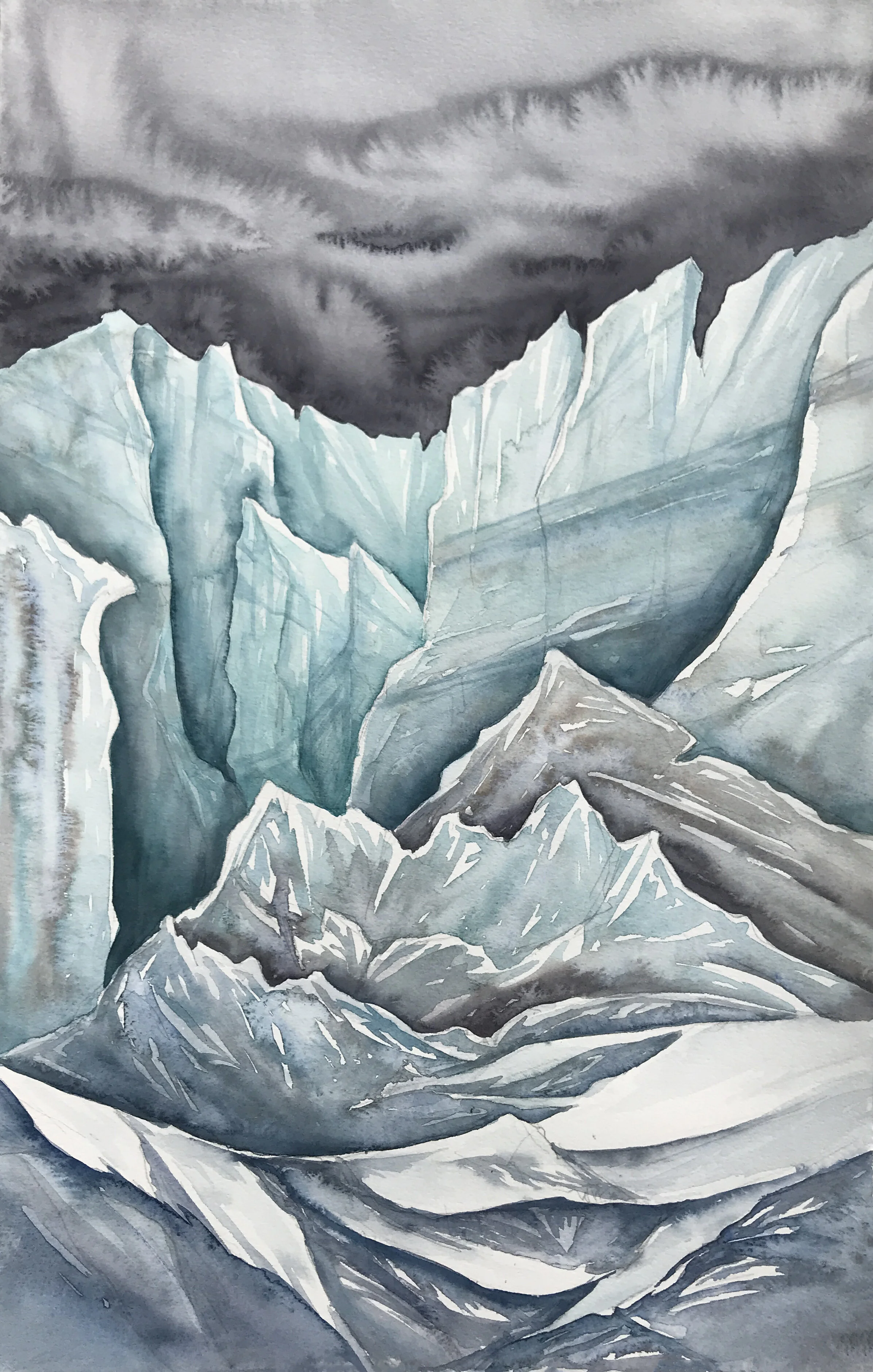
GLACIER PORTRAITS
Documenting a Vanishing Landscape
Project Origin & Description
In 2010 I painted outside for the first time. And in the splotchy brown forms of rocks that marked the recession of a glacier climate change became something very, very personal. As an artist I strive to inspire others to feel this personal connection, too. Because that is how environmental stewardship arises- when we feel something deeply enough to spur us into action.
The mountain landscapes that many of us call home are endangered. The impacts of climate change are clear – if we know where to look – but the problem is that global warming is a big, abstract concept that is hard to conceptualize and often seems very far away from our daily lives and local environments. The goal of this project is to bring the impacts of climate change to life in paintings that increase awareness and inspire environmental stewardship.
I focus on glaciers because they are “canaries in a coal mine” providing visible and dramatic evidence of global warming’s impact on mountain ecosystems. In the last 18 years glaciers in western north America lost around 117 billion tons of ice, mirroring a melting trend seen across the world. This melting impacts not only the surrounding environment but also local industry, other species, and even our ability to recreate in alpine areas. Through art I strive to make this rate of change accessible, understandable, and personally relatable. Our environment does not have a voice or a seat at the negotiation table. I aim to be that voice, because when we lose these landscapes I believe we also lose part of ourselves.
The pieces in the series include plein air (outside and on-site) paintings of melting glaciers and comparative paintings created using historical documents and crowd-sourced imagery. Project focus areas include glaciers of Washington, Greenland and Chamonix.






Press & Publication
Paintings from this project were included in my ten-page artist feature in issue 67 of Alpinist magazine and elements of the story explored in a feature interview for Issue 21 of Stay Wild magazine. In addition, I presented parts of the project at a Patagonia Seattle & Topophilia podcast event, as a lecturer on the 450 passenger Seabourn Quest ship, at a Documenting Adventure workshop in Oregon, and as a guest artist for Inspiring Girls Expeditions.
Project Partners
Arc’teryx Seattle, CREA Mont Blanc (Research Center for Alpine Ecosystems in Chamonix, France), Seabourn Cruises, and Run the Alps. My experience as a participant, volunteer, and guest instructor for Inspiring Girls Expeditions is what catalyzed the entire project.
SAMPLES OF WORK CREATED
Chamonix, France
July 2019. In collaboration with CREA Mont Blanc
Glacier Triptych. The Le Tour Glacier, Bossons Glacier, and Argentiere Glacier. Each painting was created on-site beside the ice and was accessed via human power. The section of each glacier painted captures an element of change that I observed, from the collapse of a massive fin of ice on the Le Tour to the dark exposed ice of the Argentiere painted within 30 minutes of a massive calving event.
Inspired by CREA’s research, I spent as much time as I possibly could creating paintings outside and on-site. A form of ground truth observation, these paintings reflect the dramatic and unusual seasonal changes caused by the worst heat wave to hit Europe in decades. The work created on-site can be seen here, and the comparative paintings of the Mer de Glace are here.
Nisqually Glacier, Mount Rainier. Comparative paintings of 1890 vs. 2018.
For the comparative paintings each glacier is painted twice, showing its size at least fifty years ago compared to 2018. The historical image was sourced from an old National Park pamphlet on Mount Rainier published in 1911. I created the contemporary glacier paintings by crowd sourcing imagery from large social media groups, which not only provided current imagery but also increased awareness of the changing landscape.
After my first post in the groups with a potential reach of over 100k dozens of people shared images and their observations of the landscape. Many commented that prior to seeing these paintings they had never thought of their photos as records of change, and now understand how rapidly the glaciers are receding. By sharing this series online and in public venues I hope to inspire awareness and an understanding of our role as both witnesses to change and agents in its cause. The paintings are currently on display at the Amer Sports Showroom in Seattle.
In addition, one of the individuals who shared reference imagery said: “Until seeing your paintings I had no idea how much the glaciers I hiked beside for decades have changed, and how my photos also capture the loss of ice in so little time.”


